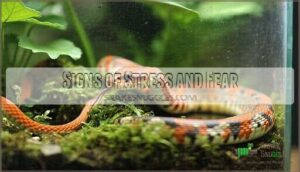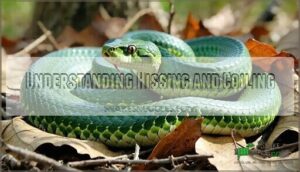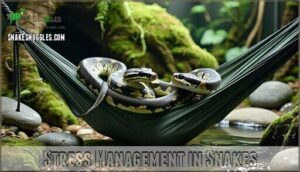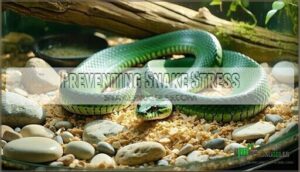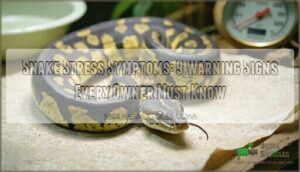This site is supported by our readers. We may earn a commission, at no cost to you, if you purchase through links.
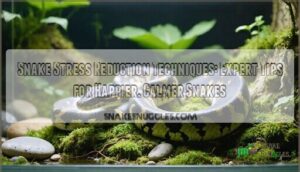
You’ll want to provide the right-sized enclosure, steady temperature, and the humidity Goldilocks would envy—not too dry, not too damp.
Handle them gently and only when necessary; even the friendliest snake appreciates personal space.
Hiding spots or branches aren’t just snake décor—they help your pet feel safe.
Watch for signs like hissing or skipped meals, which mean your buddy’s not feeling zen.
Curious about why your snake’s acting like a curled-up ball of nerves? Stick around for expert guidance.
Table Of Contents
- Key Takeaways
- Snake Handling Basics
- Reducing Snake Stress
- Snake Behavior and Body Language
- Environmental Enrichment
- Advanced Handling Techniques
- Stress Management in Snakes
- Calming a Stressed Snake
- Preventing Snake Stress
- Snake Health and Stress
- Veterinary Care for Stressed Snakes
- Frequently Asked Questions (FAQs)
- How do you deal with a stressed snake?
- How can you reduce stress in a pet snake?
- How do you calm a snake?
- How do you reduce stress on reptiles?
- How do I learn the basics of snake handling?
- How to deal with snake anxiety?
- How to reduce stress in snakes?
- How do you calm down a snake?
- How to mentally stimulate your snake?
- How to get a stressed snake to eat?
- Conclusion
Key Takeaways
- Give your snake plenty of hiding spots and climbing branches so it always feels safe and secure.
- Handle your snake gently, and only when necessary—watch for signs of stress like hissing, erratic movements, or skipped meals.
- Keep the habitat dialed in with the right temperature, steady humidity, and minimal disruptions.
- Pay close attention to body language and appetite changes so you can quickly adjust care and reduce stress.
Snake Handling Basics
When you handle a snake, you’ll need patience, the right gear, and a calm approach to keep everyone safe—snakes included.
Even the calmest corn snake can surprise you with a lightning-quick move, so it’s best to be prepared rather than outsmarted by your own pet.
Essential Equipment for Safety
Right off the bat, handling snakes safely means you’ll need your snake hook, a secure container, and sturdy protective gloves.
Proper attire is a must because snake handling safety isn’t just hype—it’s your insurance policy against surprises.
Never skip first aid supplies, either. A vital tool is a specialized handling device.
Good snake handling equipment is like a seatbelt: you hope you never really need it, and having the right gear ensures proper handling.
Choosing The Right Snake Species
Choosing the right snake species is like picking a roommate—compatibility matters.
Beginner Snakes like ball pythons have chill temperaments, while some kingsnakes enjoy a little drama.
Watch out for:
- Snake temperament—docile or daring?
- Size considerations—small or serpentine giant?
- Enclosure needs—spacious or simple?
- Lifespan expectations—years of friendship or fleeting flings?
Safety Precautions for Handling
A sturdy pair of gloves is your trusty shield for safe snake handling. Use proper attire and snake handling equipment—like hooks and secure containers—to dodge bites and boost your confidence.
Venomous handling is no place for cowboy tricks. Stay alert, use strict hygiene protocols, and always have first aid ready.
Protective gear is essential during any interaction. Here’s a quick guide:
| Safety Precaution | Why It Matters | Bonus Tip |
|---|---|---|
| Gloves & Boots | Bite Prevention | Don’t skimp on quality! |
| Snake Hook | Control & Distance | Great for nervous snakes |
| Secure Container | Safe Transport | Double-check the lock! |
| First Aid Kit | Emergency Prep | Keep within reach |
| Hygiene Protocols | Disease Prevention | Clean hands = happy snakes |
The key to successful snake handling is being prepared and staying alert, which is why having a first aid kit and following hygiene protocols is crucial for preventing disease prevention and ensuring a safe experience.
Reducing Snake Stress
Reducing your snake’s stress takes patience and a little detective work—after all, even a python has bad days.
Patience and keen observation turn tense reptile moments into trust—because even pythons deserve a break from stress.
You’ll spot calmer, happier behavior by reading the small cues and making a few simple changes, no need to charm them with a flute.
Recognizing Stress Signals
Recognizing snake stress isn’t rocket science—it starts with reading the room, scaly style.
Watch for these telltale signs:
- Rapid tongue flicking slows way down, signaling unease.
- Defensive postures like coiling and flattening scream, “Back off!”
- Appetite changes, erratic movements, or dull scales are red flags.
Careful attention to snake behavior and body language keeps everyone safe.
Recognizing these signs is crucial for maintaining a safe environment.
Adjusting Handling Techniques
After spotting stress signals, tweak your snake handling techniques for a smoother experience.
Practice a gentle approach, support the snake’s body, and start with gradual acclimation. Always read signals—if your snake seems tense, limit handling and give space.
Handling techniques built on trust turn nervous “noodles” into chill companions. Here’s a quick guide:
| Gentle Approach | Gradual Acclimation |
|---|---|
| Calm approach | Slow introduction |
| Body support | Step-by-step |
| Reading signals | Monitoring response |
| Limiting handling | Short early sessions |
| Less stress | Gains confidence |
This approach is designed to help you understand and implement gentle handling techniques, ensuring a positive experience for both you and your snake, by using a calm approach and being mindful of your snake’s needs.
Minimizing Handling Time
In the context of snake handling techniques, less is more. Keep handling frequency low so your snake doesn’t feel like it’s starring in a daily reality show.
Practice gradual acclimation and use the touch gradient—start gentle. Always allow a settling period, avoiding forced handling.
- Keep sessions brief and rare
- End sessions at first stress signal
- Prioritize stress management and calming techniques
Snake Behavior and Body Language
Understanding your snake’s behavior is a bit like learning to read a very quiet, scaly book—pay attention to body language and you’ll spot stress long before it turns into drama.
Watch for coiled bodies, rapid tongue flicking, or a hiss that sounds suspiciously like, “Please give me some space,” which can be a clear sign of stress.
Signs of Stress and Fear
Noticing snake stress means watching for stress body language. If your snake’s trying to bolt, hiding nonstop, or tossing in some erratic movements, you’ve hit the stress jackpot.
Appetite changes and skin discoloration are red flags, too. Remember: a snake in a “stress dance” isn’t looking for a tango partner—it’s flashing its stress signs.
A stressed snake might also exhibit less frequent tongue flicking.
| Snake Stress Indicator | Observable Behavior |
|---|---|
| Appetite Changes | Refuses food, weight loss |
| Hiding Behavior | Constant hiding, little movement |
| Erratic Movements | Frantic, sudden dashes |
Understanding Hissing and Coiling
After you learn the signs of stress, let’s talk about hissing and coiling. Hissing sounds are like a snake’s version of “back off.”
Coiling reasons range from getting comfy to prepping for action. Watch for:
- Defensive postures, often paired with hissing
- Tighter coils signal high alert
- Threat assessment shows in their snake body language
Snake communication keeps everyone safer by using body language to convey intentions.
Identifying Aggressive Behavior
Even when a snake stares you down like you owe it rent, don’t panic—these creatures speak volumes with their bodies.
Defensive postures, tail shakes, and sudden tensing mean you’re within striking distance.
Use your brain and handling tools, not just bravado.
Recognizing these snake stress indicators makes bite prevention less stressful—and, frankly, less painful—for everyone.
| Signal | Meaning | Your Response |
|---|---|---|
| Hissing | Defensive Posture | Pause, reassess |
| Coiled stance | Threat Assessment | Move carefully |
| Quick strikes | Snake Aggression | Use Handling Tools |
The table provides a clear guide to understanding snake behavior, with signals such as hissing and coiled stance indicating specific meanings and required responses.
By following these guidelines, you can better navigate interactions with snakes and reduce the risk of snake aggression.
Environmental Enrichment
You can help your snake feel safe and curious by creating an environment with plenty of places to hide, climb, and stretch out.
Even snakes enjoy a little redecorating—imagine their excitement when they discover a new log or leafy hideout in their enclosure.
Creating a Naturalistic Environment
Understanding your snake’s quirky body language is just the beginning; now it’s time to channel your inner architect.
Think big on Enclosure Size and mix up Substrate Choice—skip the pine shavings!
Natural Lighting helps a lot, while environmental adjustments like steady temperature control and ideal humidity levels make your snake habitat a cozy spot.
Snake stress reduction? Mission possible!
Providing Hiding Spots and Climbing Branches
Stacking rocks, tucking hide boxes, and tossing in sturdy branches can turn your snake enclosure into a five-star resort.
Go for plenty of hide variety—think logs, caves, and even upside-down flower pots.
Match branch diameter to your snake’s girth for climbing safety.
Many keepers find success using a specialized hide box to provide security.
Enclosure clutter isn’t a mess here; it’s primo environmental enrichment, fighting tank environment stress and boosting enrichment activities.
Maintaining Proper Temperature and Humidity
After you’ve added hiding spots and climbing branches, don’t overlook the basics—temperature gradients and humidity levels.
Keep your snake’s enclosure dialed in like a finely tuned instrument. A small slip in thermostat accuracy might lead to shedding problems or even respiratory infections.
- Monitor temperature daily.
- Invest in reliable humidity control.
- Ectothermic pets appreciate when you keep their habitat steady.
Advanced Handling Techniques
When handling snakes, you’ll want to use advanced techniques to keep both you and your reptile safe, whether you’re transporting them, warming them up, or faced with an especially feisty character.
It’s a bit like mastering the gentle art of carrying soup—steady hands, a calm presence, and a good sense of timing make all the difference.
Transporting Snakes Safely
You’ve nailed the perfect habitat, but now the challenge is safe transport. Always use a secure, ventilated container—think “no snake escape acts!” Choose sturdy bag material and double-check container security for every trip.
Monitor handling during veterinary transport, since careful moves cut down snake stress. Good transport keeps temperature regulation on track.
Here’s a handy comparison:
| Aspect | Quick Tip |
|---|---|
| Container security | Latching lids help—no last-minute surprises. |
| Bag material | Use cloth, never plastic, for stress management |
| Handling during | Stay calm, go slow, minimize stress. |
| Veterinary transport | Cushion bumps; snakes dislike turbulence. |
| Temperature regulation | Avoid extremes. Comfort = safer travel. |
Using Warming Devices and Insulation
After you’ve secured your snake for travel, keeping it warm becomes the next puzzle.
Place warming devices under or beside the container—not in direct contact. Always insulate them from your reptile to avoid thermal burns.
For quality options, consider specialized reptile heaters. Control device temperature and choose insulation material carefully.
Remember, different species need specific heat and gradual temperature changes. Humidity control matters too, so don’t let things get muggy!
Handling Aggressive or Debilitated Snakes
Aggressive snakes can be real adrenaline machines, often reacting quickly to Aggression causes like loud noises or sudden moves.
Watch for Debilitation signs: lethargy, poor coordination, or unsteady breathing. Use Safe restraint—think gloves and gentle pressure.
Feeding challenges may arise, so don’t force it. Veterinary intervention matters for worrying signs.
Mastering snake handling means knowing when hands-off beats heroics for snake stress reduction.
Stress Management in Snakes
You’ll spot a stressed snake by noticing changes in behavior, appetite, or appearance—sometimes even quicker than you notice your own bad hair days.
Paying attention to these signs lets you act early, helping your snake feel safer and maybe even less dramatic than your high school group chat, which can be quite dramatic.
Physical Signs of Stress
When handling snakes, pay close attention to snake body language.
Stress signals often include Skin Discoloration, Eye Dilation, and Muscle Tremors.
You might spot Rapid Breathing or even Jaw Gaping—it’s their way of saying, “Not loving this!”
Good snake stress symptoms recognition means checking for subtle changes in snake behavior, like more hiding behavior than usual.
Reading these clues gives you control and helps you understand the importance of recognizing stress signals.
Behavioral Changes and Appetite Loss
Spotting stress symptoms in your snake? Listen up for these telltale signs:
- Refusal to eat, showing clear loss of appetite
- Erratic movements or sudden darting
- Hiding excessively or being less social than usual
- Defensive postures, like striking or coiling
When you notice these behaviors, it’s your cue to review and adjust your husbandry. Even snakes like their routines.
Lethargy and appetite loss can also indicate underlying snake diseases, such as those found at underlying snake diseases, which can be a sign of a more serious issue, including lethargy and loss of appetite.
Early Recognition of Stress Symptoms
If your snake skips meals, looks pale, or slithers like it’s running late for a date, you might be seeing early snake stress symptoms.
Recognizing mood swings and odd snake body language helps. Watch for skin discoloration, erratic movements, or appetite changes—these behavioral changes often signal stress.
| Symptom | What it Means |
|---|---|
| Skin Discoloration | Physical Indicator |
| Appetite Changes | Snake Stress Clue |
| Erratic Movements | Stress Signal |
Catching these signs early can prevent bigger health headaches.
Calming a Stressed Snake
When your snake gets stressed, it’s like watching a spaghetti noodle try to leap from its bowl—awkward and rarely successful.
You can calm your snake by handling it gently, limiting interaction time, and making its habitat as cozy as your favorite reading nook, which can help reduce stress.
Gentle Handling and Support
When stress pops up, your Calm Approach matters most. Use two hands for full Body Support and make Slow Movements—they notice every twitch. Think of gentle handling as the “hug, don’t squeeze” rule.
Understanding snake body language can further aid in stress reduction. This keeps Snake Stability and helps you notice stress signals early.
Add these to your snake handling techniques:
- Lift with both hands
- Avoid sudden jerks
- Watch for body cues
Reducing Handling Time and Frequency
Once you’ve mastered gentle support, it’s smart to rethink how often and how long you handle your snake.
Shorter Handling Session Lengths and fewer sessions let your pet relax and adjust at its own pace.
Rushing with Forced Handling can backfire, and it’s essential to rethink your approach to allow for a generous Settling Period—snakes appreciate a hands-off approach regarding stress management!
Creating a Calm Environment
After you’ve got a handle on reducing how often you interact, focus on the tank setup.
A secure enclosure with minimal disturbances goes a long way toward keeping your pet comfy.
Quiet handling, a consistent routine, and gradual introduction to changes help prevent stress.
It’s all about creating an ideal environment—think stress prevention with proven calming techniques, not just snake décor shopping.
Preventing Snake Stress
You can’t prevent every snake stress with a magic wand, but you can spot the main causes like an uncomfortable habitat or rough handling.
When you know what makes your reptile uneasy, you’ll keep your snake happy, and maybe even catch them snoozing instead of plotting escape.
Environmental Causes of Stress
Tranquility doesn’t just happen—it takes the right tank setup. Think like a snake: would you relax cramped in a shoebox?
Environmental causes of stress include:
- Too-small enclosure size, which leaves no room to stretch or hide
- Inconsistent temperature control and wild humidity levels
- Lack of naturalistic stimuli, turning Habitat Security into a game of hide-and-seek gone wrong
A cozy setup yields a calmer snake.
Stress Caused by Incorrect Handling
While temperature and enclosure problems might set a snake on edge, rough handling’s like inviting thunder to a picnic.
Quick grabs, ignoring the acclimation period, or skipping gradual habituation can trigger handling induced stress.
Use proper restraint techniques, stay calm, and always prioritize avoiding snake bites.
Adapt your approach—snake handling thrives on good observation, stress management, and calming techniques, not speed.
Providing a Comfortable Habitat
A comfy snake habitat isn’t just a luxury—it’s a lifeline against stress.
To keep your reptile’s environment secure and inviting:
- Choose the right enclosure size for your species.
- Use natural substrate to encourage burrowing.
- Provide a thermal gradient and proper lighting.
Dial in humidity levels, make small environmental adjustments, and watch snake stress slither away!
Snake Health and Stress
You’re the main scientist in matters of spotting changes in your snake’s health and stress levels, whether that’s a skipped meal or a stretch of odd behavior.
Think of yourself as the Sherlock Holmes of scales—notice the clues early, and you’ll keep your snake happy (and out of detective novels).
Signs of Illness and Injury
You might notice skin abnormalities, like odd patches or retained shed, that look more “fashion risk” than natural.
Watch for respiratory distress—open-mouth breathing, wheezing, or odd discharge analysis from the mouth or nose.
Spot unusual lumps and mobility issues quickly, as these red flags signal stress symptoms, impact snake health, and warrant quick action before loss of appetite or weight loss strikes.
Weight Loss and Appetite Changes
Keep an eye out for loss of appetite and weight loss in your snake. These can sneak up like thieves in the night and signal real trouble—not just brumation prep.
Watch for:
- Refusal to eat
- Unexpected weight loss vigilance
- Nose rubbing injuries
- Hissing signals stress
- Sudden changes in snake appetite or diet
Don’t let stress slide. Lethargy can also be a sign, so watch for signs of illness.
Veterinary Care for Stressed Snakes
If your snake looks unwell or has stopped eating for days, it’s time to let a reptile-savvy vet take center stage.
You don’t have to be a snake-whisperer—a professional can spot problems faster than you can say “shed.”
When to Visit a Vet
Your snake’s odd behavior or sudden physical injuries are waving a big red flag—time for a vet checkup.
If you spot Emergency Symptoms, subtle Behavior Changes, or want proactive Preventative Care, don’t hesitate to call in a specialist.
Vet consultations help catch stress symptoms early and dial up your stress management game, which is crucial for prioritizing snake wellbeing and beats rolling the dice, emphasizing the importance of stress management.
Signs of Severe Stress or Illness
Don’t ignore signs like lethargy and weakness, abnormal shedding, open wounds, or trouble breathing—your scaly buddy isn’t just having an off day.
Watch for neurological issues too, like odd movements.
Fast snake stress symptoms recognition means quicker snake stress treatment.
Spotting snake stress causes early helps with snake stress prevention, so you’ll avoid a reptilian emergency room visit!
Getting Professional Help for Snake Care
When your scaly friend acts like they’ve got ants in their pants—or maybe stops eating or hides 24/7—it’s time to seek professional help.
An exotic vet visit, a snake behaviorist consult, or even emergency snake care can work wonders.
Specialized snake rescues and reptile veterinarians offer guidance, long-term care planning, and snake behavior modification, and herpetologists have seen it all, so don’t be shy—they can provide expert help.
Frequently Asked Questions (FAQs)
How do you deal with a stressed snake?
When your pet acts like a coiled spring, step back and let it chill in its hide.
Dim the lights, cut out noise, handle only when needed, and offer gentle support—patience is your best tool.
How can you reduce stress in a pet snake?
Give your buddy plenty of hiding spots, keep the tank at perfect temps, and don’t over-handle—even Houdini needs downtime.
Watch for hissing or rapid tongue flicks.
Every slither tells a story—sometimes that tale means “leave me be.”
How do you calm a snake?
Move slowly, approach from the side, and support the snake’s body with both hands.
Stay calm—your nerves are contagious.
Watch its behavior for signs of stress.
Soft words don’t hurt, but a firm touch always helps.
How do you reduce stress on reptiles?
Isn’t it curious how creatures barely make a peep, yet they crave routine?
You’ll want to maintain stable temps, add hides, minimize handling, and don’t skip enrichment.
Keep things familiar—your reptile’s nerves will thank you.
How do I learn the basics of snake handling?
Start with basic safety gear—gloves, boots, snake hook—and get comfy with snake behavior.
Approach slowly, support their body, and avoid fast movements.
It’s all about patience and steady hands. Remember, snakes can sense nerves faster than Wi-Fi!
How to deal with snake anxiety?
Picture holding a nervous corn snake in biology class—it hisses, coils tighter than a phone cord, and shimmies in your hands.
Don’t panic; stay calm, move slowly, support its body, and remember: patience calms most anxious reptiles.
How to reduce stress in snakes?
Keep your snake’s home cozy and cluttered with hides and branches, like a five-star reptile resort.
Handle them gently, limit poking around, and give them alone time after meals.
Even snakes love a bit of peace and quiet!
How do you calm down a snake?
Like a tightrope walker craves steady ground, your snake wants calm.
Approach slowly, support its body, and speak softly.
Skip sudden moves.
Humor helps: snakes aren’t fans of interpretive dance.
Gentle, patient handling builds trust every time.
How to mentally stimulate your snake?
Offer your snake plenty of climbing branches, tunnels, and hideouts.
Change up their enclosure layout now and then.
Toss in a puzzle feeder or scent trail—watch curiosity kick in as your reptile detective investigates every nook!
How to get a stressed snake to eat?
Don’t worry—sometimes even the chillest snakes skip meals.
Dim the lights, offer their favorite prey warmed up, and give them plenty of hiding spots.
Give them privacy and patience; forcing the issue rarely works—snakes appreciate subtlety!
Conclusion
Let’s call a stressed snake “out of sorts”—but with the right snake stress reduction techniques, you’ll restore calm in no time.
Give your scaly housemate a cozy, well-furnished home, and gentle handling with lots of patience.
Recognize those subtle signals before they become a hissy fit, and you’ll both avoid headaches.
With science-backed care and a little empathy, you’ll put your snake’s nerves to rest.
After all, nobody likes a cranky roommate, human or reptile!
- https://pmc.ncbi.nlm.nih.gov/articles/PMC11926773/
- https://www.evolutionreptiles.co.uk/blog/enriching-reptile-lives-a-guide-to-environmental-enrichment/
- https://aminoapps.com/c/reptiles/page/item/stress-in-ball-pythons-and-how-to-prevent-it/z6gj_gV4hwIY6r14EBL6pJzZDDrvoZ8kJ73
- https://kb.rspca.org.au/knowledge-base/how-will-i-keep-my-reptiles-entertained-alert-and-interested-in-their-surroundings/
- https://community.morphmarket.com/t/tips-to-lower-stress-of-a-ball-python/49312


